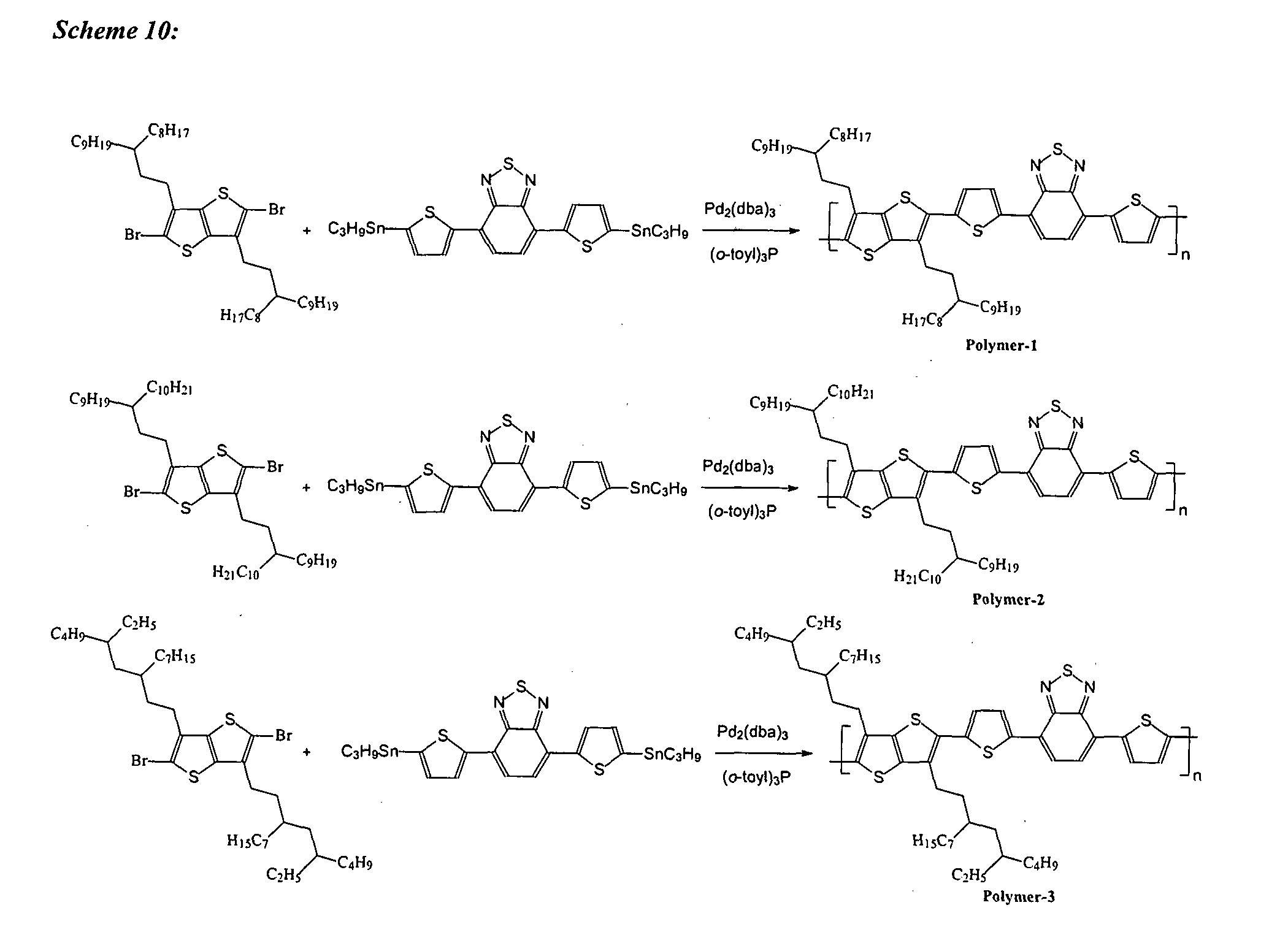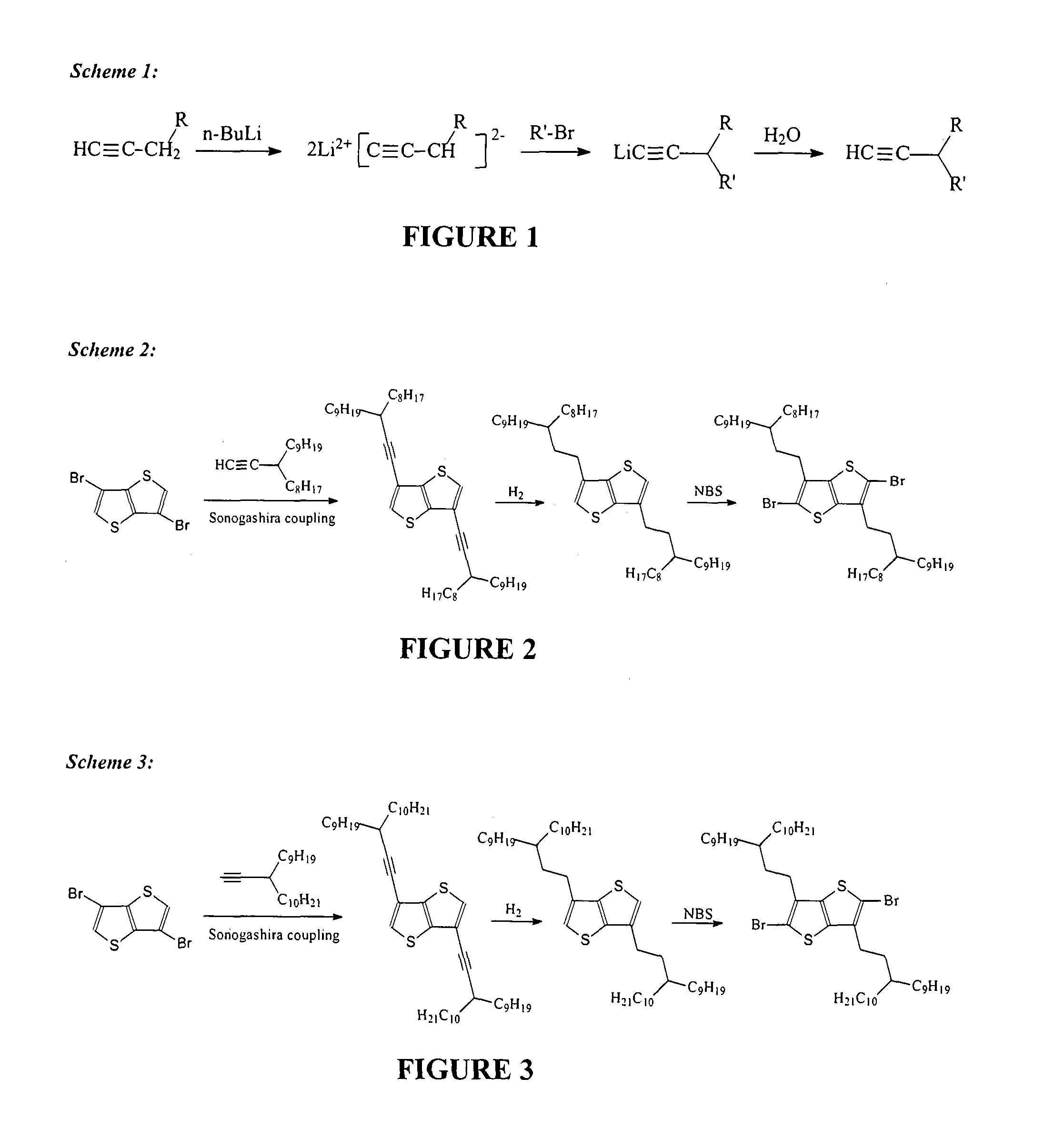P-type semiconducting polymers and related methods
a semiconducting polymer and polymer technology, applied in the field of p-type organic polymers, can solve the problems of shortening the conjugation length along the polymer backbone, and achieve the effect of improving the processability of device fabrication and improving the power conversion efficiency of electronic devices
- Summary
- Abstract
- Description
- Claims
- Application Information
AI Technical Summary
Benefits of technology
Problems solved by technology
Method used
Image
Examples
example 1
Synthesis of 3-Alk-1-Ynes
[0140]Generally, 3-alk-1-ynes were synthesized according to the reaction described in Scheme 1 (FIG. 1), and as follows.
3-Octyldodec-1-yne
[0141]1-dodecyne (25.00 g, 0.15 mol) was added into a 500 mL Schlenk flask. The flask is then purged thrice with N2. 100 mL of freshly prepared anhydrous THF was added into the flask under N2 protection. The solution was cooled and maintained at −20° C. for 30 min in an ice-acetone bath. n-BuLi (190 mL, 1.6 M, 0.305 mol) was added dropwise into the flask. The reaction mixture was kept stirring at −20° C. for 8 hrs, then left to react overnight with warming up to room temperature. The reaction solution was cooled down to −20° C. again. 1-Bromooctane (31.68 g, 0.15 mol) was added and the reaction stirred for one day with warming up to room temperature. 50 mL ice water was added into the flask to quench the reaction and the mixture was extracted with hexane (3×50 mL). The combined organic extracts were then washed with dilute...
example 2
Synthesis of 2,5-Dibromo-3,6-Bis(3-Octyldodecyl)Thieno[3,2-b]Thiophene
[0144]2,5-Dibromo-3,6-bis(3-octyldodecyl)thieno[3,2-b]thiophene was synthesized according to the reaction set out in Scheme 2 (FIG. 2), and as follows.
3,6-bis(3-octyldodec-1-yn-1-yl)thieno[3,2-b]thiophene
[0145]To a solution of 3,6-dibromo-thienothiophene (2.98 g, 0.01 mol) and 3-octyldodec-1-yne (6.96 g, 0.025 mol) in triethylamine (80 mL) were added dichlorobis(triphenylphosphine) palladium(II) (280 mg, 0.4 mmol) and copper(I) iodide (74 mg, 0.4 mmol). The reaction mixture was stirred at 80° C. overnight. Solvent removal by evaporation gave a residue that was purified by flash column chromatography using hexane as eluent. The crude product was collected as yellow liquid (6.9 g, 96% yield) for the next step. 1H NMR (400 MHz, CD2Cl2) δ 7.41 (s, 2H), 2.59 (m, 2H), 1.56-1.28 (m, 60H), 0.89 (t, J=6.4 Hz, 12H).
3,6-bis(3-octyldodecyl)thieno[3,2-b]thiophene
[0146]To a solution of 3,6-bis(3-octyldodec-1-yn-1-yl)thieno[3,2-...
example 3
Synthesis of 2,5-Dibromo-3,6-Bis(3-Nonyltridecyl)Thieno[3,2-b]Thiophene
[0148]2,5-Dibromo-3,6-bis(3-nonyltridecyl)thieno[3,2-b]thiophene was synthesized according to the reaction set out in Scheme 3 (FIG. 3), and as follows.
2,5-dibromo-3,6-bis(3-nonyltridecyl)thieno[3,2-b]thiophene
[0149]The same procedure as the preparation of 2,5-dibromo-3,6-bis(3-octyldodecyl)thieno[3,2-b]thiophene. White crystal was obtained with a yield of 86%. 1H NMR (400 MHz, CD2Cl2) δ 2.67 (t, J=8.0 Hz, 4H), 1.62 (m, 4H), 1.29 (m, 70H), 0.90 (t, J=6.4 Hz, 12H).
PUM
| Property | Measurement | Unit |
|---|---|---|
| thick | aaaaa | aaaaa |
| thick | aaaaa | aaaaa |
| thick | aaaaa | aaaaa |
Abstract
Description
Claims
Application Information
 Login to View More
Login to View More - R&D
- Intellectual Property
- Life Sciences
- Materials
- Tech Scout
- Unparalleled Data Quality
- Higher Quality Content
- 60% Fewer Hallucinations
Browse by: Latest US Patents, China's latest patents, Technical Efficacy Thesaurus, Application Domain, Technology Topic, Popular Technical Reports.
© 2025 PatSnap. All rights reserved.Legal|Privacy policy|Modern Slavery Act Transparency Statement|Sitemap|About US| Contact US: help@patsnap.com



